-
Posts
1,261 -
Joined
-
Last visited
Content Type
Profiles
Forums
Events
Store
Posts posted by Andrej Stancak
-
-
The image below gives a good idea about Prayer Man's left leg. It is important to understand whether Prayer Man's left leg was bent or not. If the left leg were bent, Prayer Man could only stand by placing the weight of his body on his right foot, in line with the "one-foot-down-one-foot-up" hypothesis.. This composite picture refers to frame #003267 which is one of the earlier frames in Darnell film depicting the doorway; the lady in white had not ascended too far yet and therefore, the view of Prayer Man's left leg is not obstructed.
The top row shows the cut of the original frame (left), and the brightness coded (unprocessed) images of the same image, one in grey (middle) and one colour-coded (right). The bottom image shows Prayer Man rotated 90 degrees and from his left. Thus, Prayer Man's head would be on the right-hand side and feet on the left-hand side, and Prayer Man is in supine position. I have highlighted the course of the left leg with a purple line. The left thigh gradually rises toward the brighter tones and the maximum, possibly the knee, approaches the brightness of the right arm. There is a bulky bright (white) object next to Mrs. Reese, below Mrs. Reese's right hand. This object, (radiator?), is clearly separated from Prayer Man's body and should not be confused with Prayer Man's left leg. Notably, the shin is clearly bent inward and this is the reason for a slightly darker spot in the region below Prayer Man's left knee in the original picture.
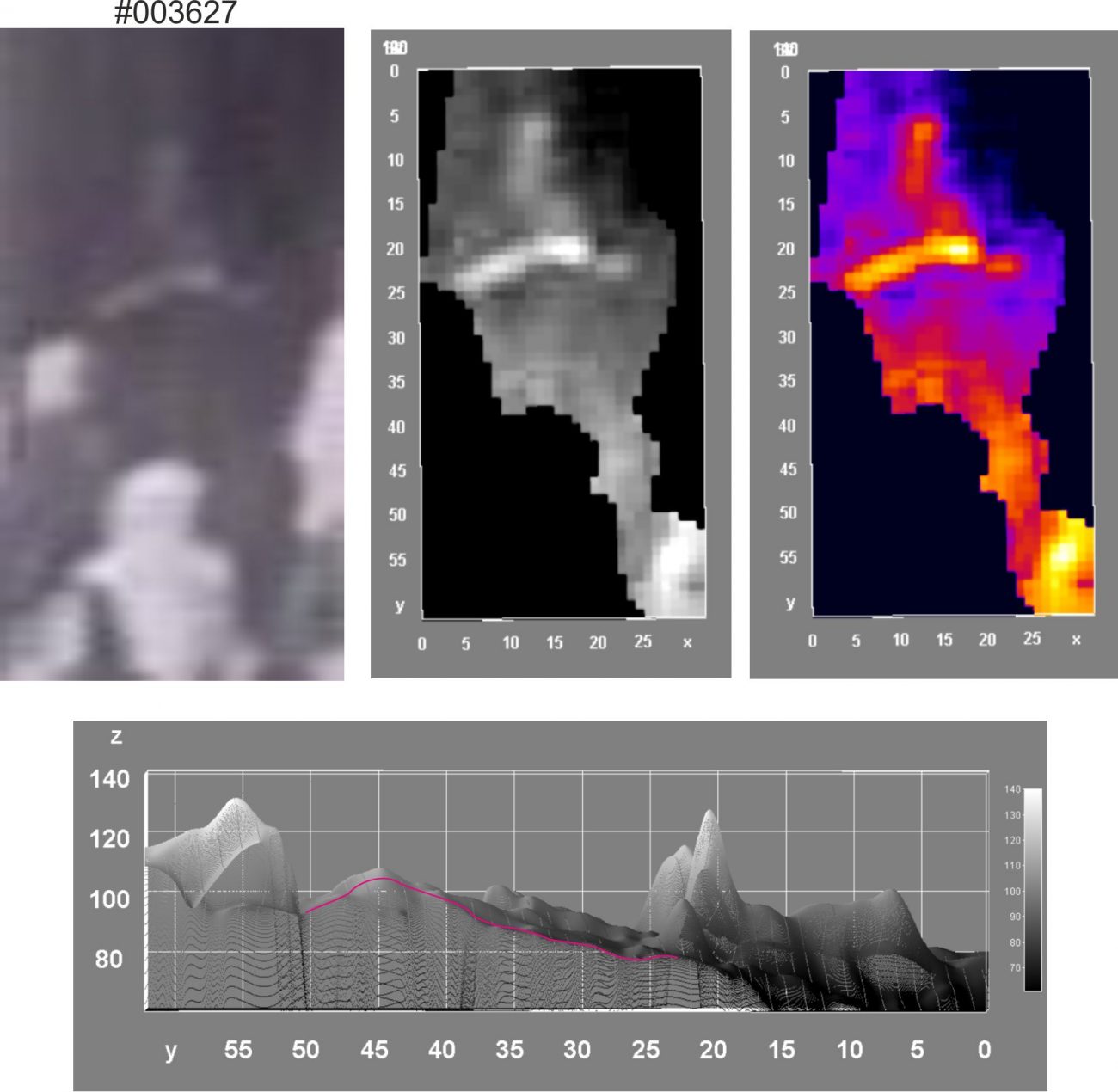
-
In have applied "Fade correction" in CorelPaintshopPro program with a very small correcting factor, and lightened up the yellow tones. The photograph of CE151 after applying tools to mitigate the ageing process looks as follows:

And here is a comparison of the CE151-WC and the CE151-2016 (the one which NARA photographed anew in 2016 and sent to Pat Speer):
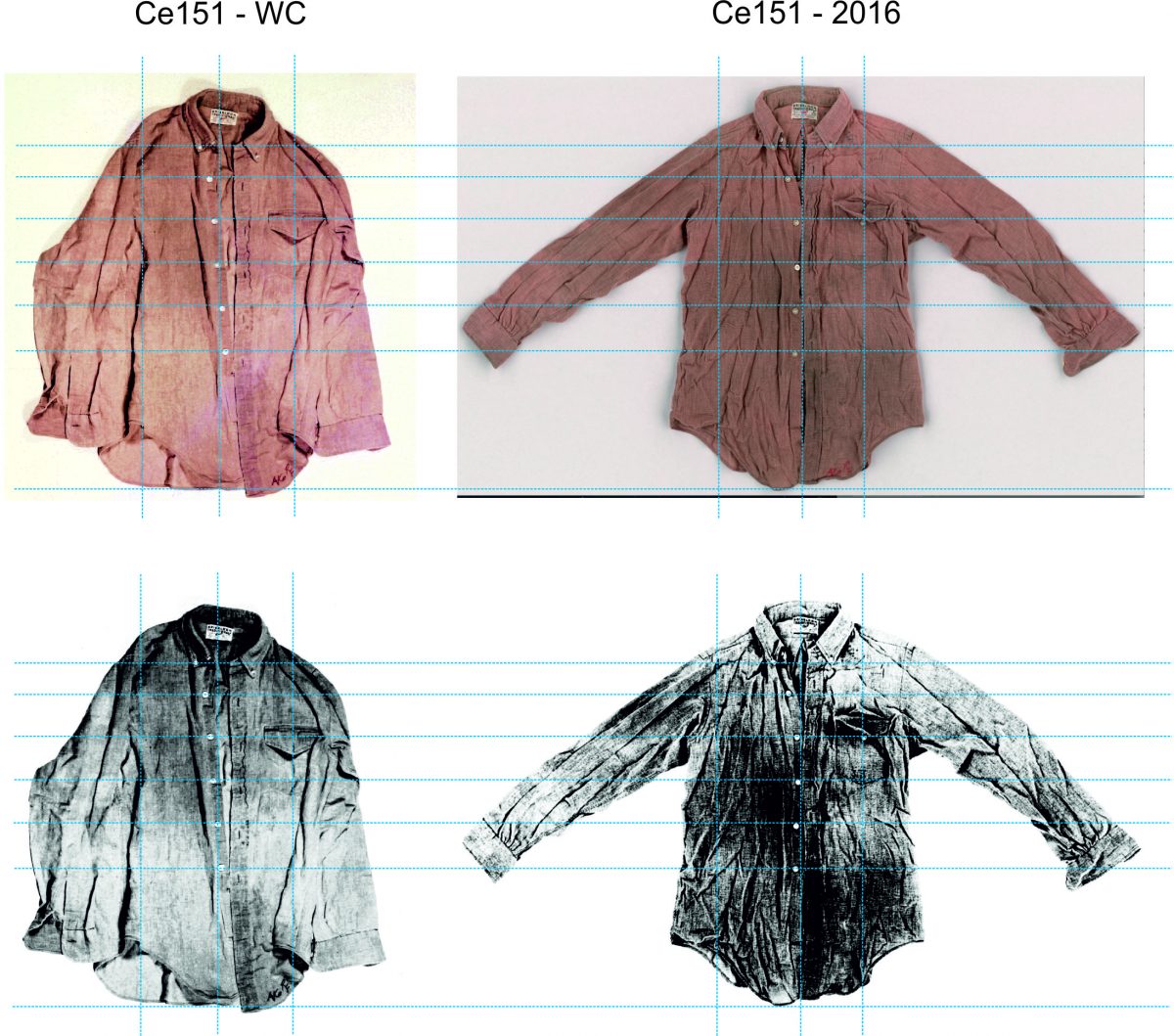
-
Coming back to the issue of CE151, the reddish shirt which Lee Oswald most likely wore on the Friday morning, November 22, 1963, I have placed a request to the National Archives to send me the original photograph of the shirt as appearing in the Warren Commission Hearings, vol. XVI. I have received a message from NARA that the access to the photograph was in the remits of the Special Access unit and I was provided with an email address. About a week after my email to the Special Access unit, I received a message with the photograph of the shirt CE151 in the attachment with a note that the photograph is faded due to the age. NARA sent this image as a courtesy.
Here is the coloured photograph of CE151 which has been known so far as a rather poor-quality black-and-white photograph copied from a scan of the Commission Hearings, vol. XVI, page 515.
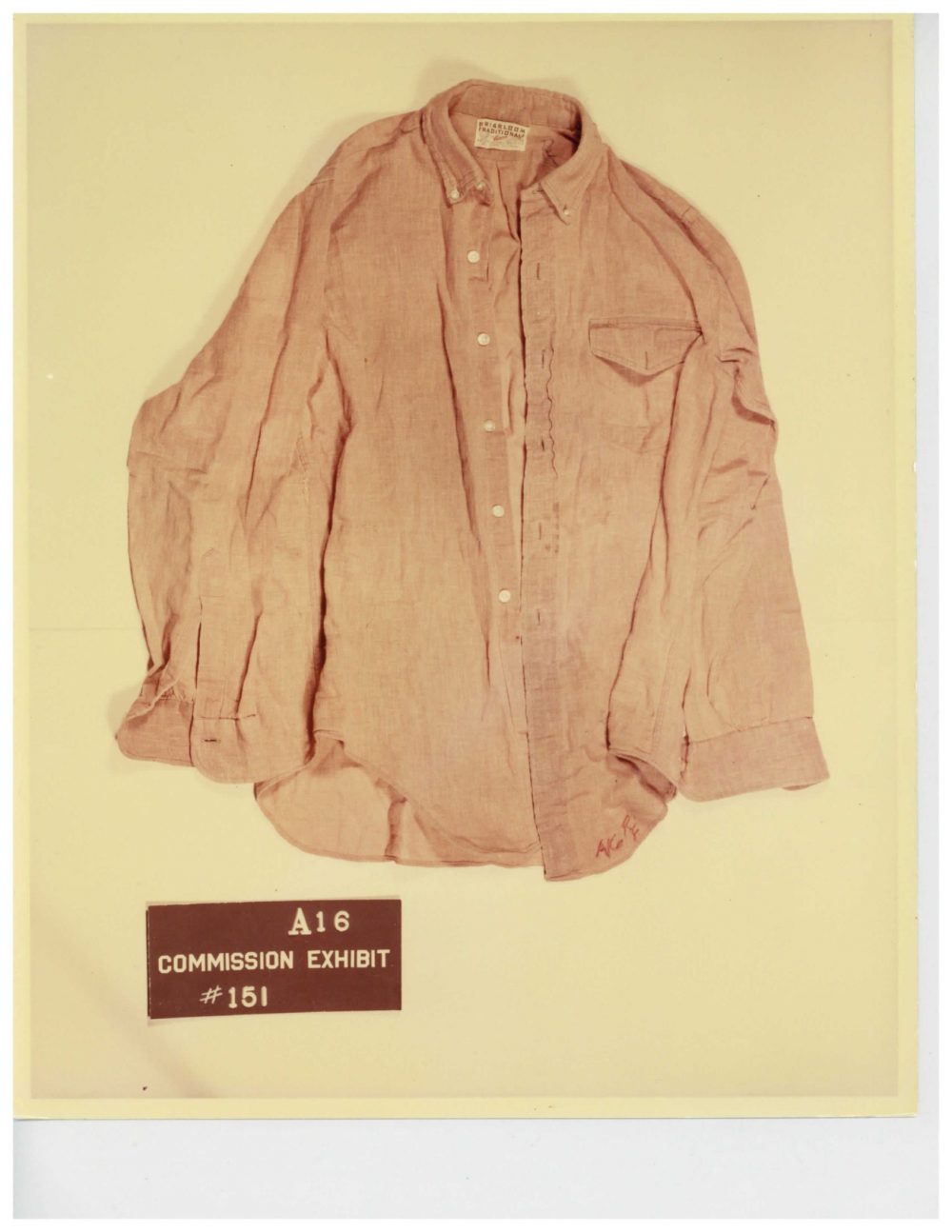
-
1 hour ago, Adam Johnson said:
Hi Andrej,
Do you think that the right wrist area of prayer man is covered by a watch/leather band or some type of jewellery or is it just shaded/out of sunlight????
Adam:
I see no evidence of an object such as wristwatch on Prayer Man's right wrist. The bright blob, in my opinion, is the protrusion of the lateral of the two elbow bones, the ulnar bone. The protrusion, the styloid process, creates a bump just before the narrowing of the wrist. This man appeared to have a quite distinct protrusion at the distal part of ulnar bone, and this could have created a brighter spot in Prayer Man's wrist area.
I have extracted, for comparison purposes, the forearm and hand of Lee Oswald posing in the backyard photograph. It is obvious that this photograph shows a number of features which point to photographic manipulation. Without wishing any discussion about the origin of backyard photographs, I assume that some of the backyard photographs were both genuine and manipulated. The obvious manipulation may have been implemented to offer plausible deniability in any trial.
Anyway, the man posing as Lee Oswald had the styloid process of the ulnar bone very well expressed and a bit far from the dorsum of the hand. Here is a composite showing the backyard photo with the region of interest (forearm and hand) delineated with a yellow line, and Prayer Man's colour-coded brightness of his forearm and hand (right-top) and the colour-coded forearm and hand in the man in the backyard picture (right-bottom). The arrow points to the extruded styloid process on the ulnar bone.
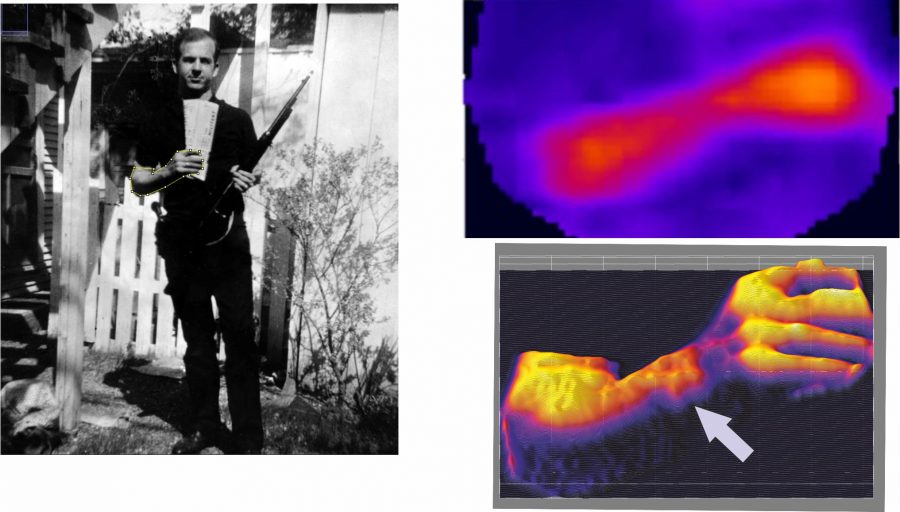
-
Pat:
Tom Wilson was secretive, and he was a bit mistrustful as far as official investigations and agencies are concerned. Tom trusted his work very much, not leaving any grain of doubts, and this is always a bit risky. However, his work cannot be ignored and it is a challenge for the 21st-century scientists to understand the theoretical basis of his methods, replicate his methods and results, and more importantly, to try to extract novel information from photographs which Tom Wilson did not analyse, such as Darnell. I agree with Ray that one would need to be in Tom Wilson's shoes to understand all his attitudes.
-
Bart, thanks for posting this old conference presentation by Tom Wilson.
I thought that this recording was lost forever, and it now surfaces with all the music in the background which eyewitnesses remembered well. Here is a post by the Bernice Moore, dated March 9, 2007, which gives some more context to this video:
I saw both of Wilson's initial public presentations. The first was at the Assassination Symposium on John F. Kennedy (ASK) in Dallas in 1991. It was a presentation
involving charts of mathematical calculations and color slides of computer-processed images. That debut of Wilson's work was videotaped by South by
Southwest, the conference organizers, but the quality of the presentation and the video was compromised by a loud party in the next-door ballroom. The two ballrooms
were separated by a non-soundproof, movable partition. In what is at best an amazing coincidence, that party was part of a reunion of U.S. Secret Service agents,
some of whom had served on Kennedy's Dallas trip. That was learned about three years later by Vince Palamara while interviewing some of those former agents.
-------------------------------
The video gives some more insight into Tom's results compared to what is known from Don Phillips's book, however, practically no information about his methods. Apparently, Tom Wilson was willing to talk about his methods, however, nobody had asked proper questions at that time.
-
Pat:
As far as I know Tom Wilson and his work, your statements appear to me as very harsh. Tom Wilson was not aware that he was being filmed, and he was not selling or advertising his work. Actually, Tom Wilson expressed his disagreement with being filmed. However, he was very enthusiastic about his work and results which is something what researchers often show. He was just sitting in the kitchen with three people whom he trusted and took some minutes to explain his findings. Tom Wilson was indeed very interested in finding out the truth and it is simply shameful to cast any doubts on Tom's work or character posthumously. This was a friendly chat among three people, not a professional interview of Jerrold Custer or Tom Wilson.
-
I have made a few new arms and left leg postures to accommodate the sequencing of bright-dark tones shown in my previous post. For Prayer Man to have his left hand in the shadow, he would need to have his whole chest rotated a few degrees toward the wall. The initial step is always to model the posture in Poser 11.1 and overlay it onto Darnell still to see if all body parts would fit. The new posture with the left arm slightly back due to the rotation of the chest appears to match Prayer Man's figure well. The top right-hand panel shows an overhead view of the new posture in which the sequence of the brightest spots would be represented in Prayer Man's mannequin. The bottom right-hand panel shows the posture I used so far. This Poser-Darnell analysis needs to be repeated over a few days because small details can only be spotted after giving it some rest. Only then is the pose exported from Poser as *.obj file, converted into a Collada *.dae file in AT3D, and imported into Sketchup. The Artisan sculpting toolbox is then used to sculpt the face and hair according to Lee Oswald's photographs and to modify the Poser mannequin's clothes. So, you better are sure that the model which will be used for the final analysis holds. There are a few other tests applied before I start sculpting. I have a mini-doorway with only basic features and first test if the imported 3D figure can actually stand as we see it in Darnell. It takes about 2-3 weeks to create an Oswald' mannequin posing in a new posture. The black line separates Prayer Man from the contour of the lady in white.
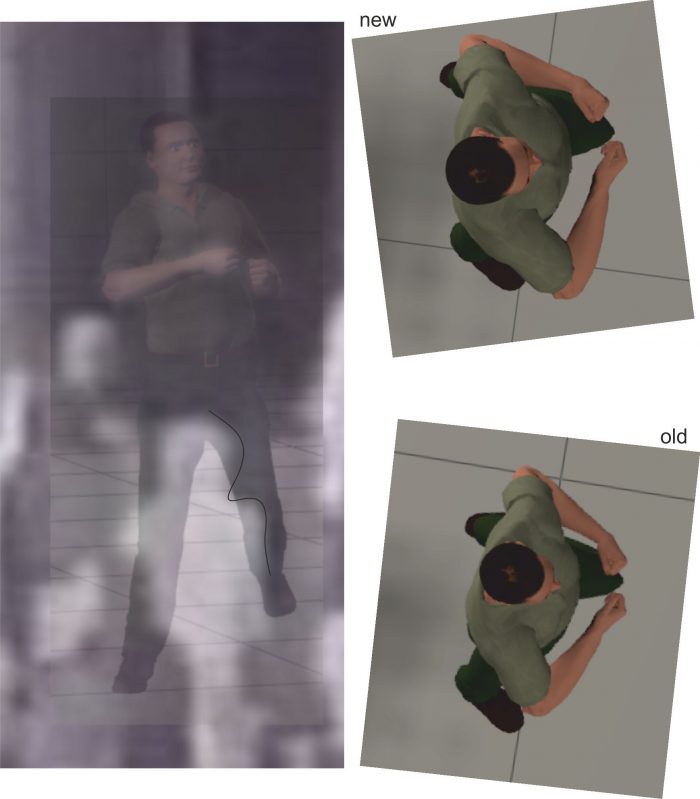
-
A detail of the right hand and forearm revealing that the dorsum of the right hand was indeed the brightest spot in Prayer Man's figure. The yellow lines in the left-hand panel delineate the region of interest which was then processed in ImageJ program. The right-bottom panel shows the brightest areas as the tallest and orange.
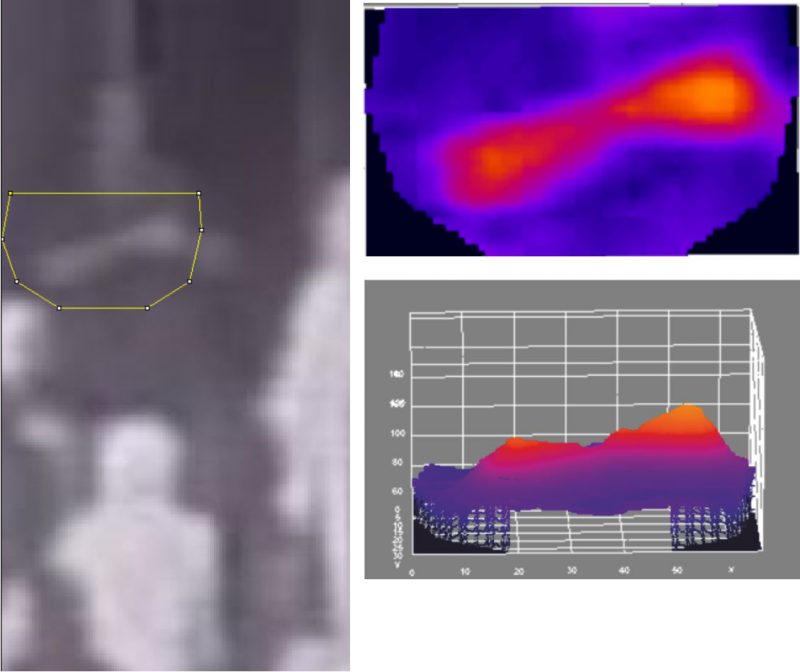
-
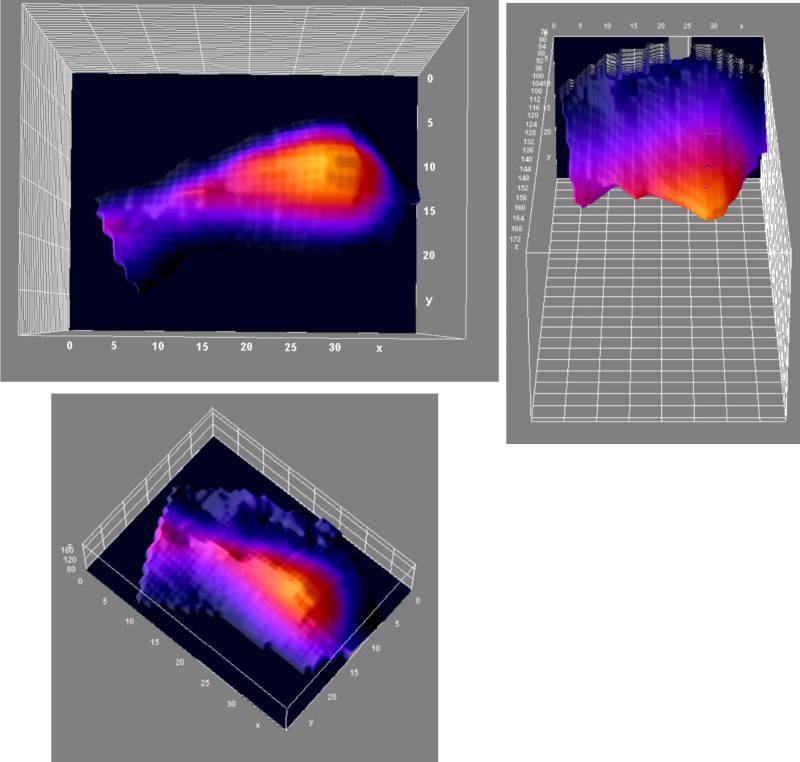
This is a 3D detail of Prayer Man's right hand in different views. There is a small irregularity in the wrist area which may be the styloid process of ulnar (or radial) bone. Some fingers can be recognised which is something difficult to achieve just by looking at the picture as it is.
-
This is a composite picture showing in the upper panel the progression in the appearance of bright tones in Prayer Man's figure. The first picture from the left in the upper row reveals that the brightest part in Prayer Man's figure was the back of his right hand. The fleshy part of the forearm close to the elbow joint follows, and the region which I believe would be the left knee or a lateral aspect of the left thigh is the next (the third picture from the left). The left hand only appears when the face is visible; however, it is possible that the left hand is in the shadow cast by the right hand/forearm, so it may still be in front of the chest.

In the lower panel, the three spots which pop up first are overlaid onto Prayer Man's figure. The CE151 is also shown because as less bright tones in Prayer Man's figure are picking up, there are inexplicable holes on Prayer Man's shirt. The part around the Prayer Man's abdomen should never be dark if the shirt was of even colour, however, it is not. There are dark areas which are sunk into the shirt, and those darker spots correspond with the dark spots on CE151-WC.
-
We are trying to understand details which are buried in an old, blurry photograph. It is easy to go astray and there is no shame in doing so.
-
7 hours ago, Chris Davidson said:
I'll reserve my comments for now.

Welcome back, Chris. I guess I can now explain the shadow conundrum better, however, I need to take some pictures and also correct the positions of both arms (hands) in my last model. This may take a few days.
-
19 minutes ago, Sandy Larsen said:
In the meantime....
Andrej,
You may want to double-check the sentence you added, calling it a "Late edit." In my neck of the woods, your asking:
Chris, would you agree that a person 5'2 1/2'' or 5'3'' would hardly be a woman?
would be roughly equivalent to asking:
Chris, would you agree that a person 5'2 1/2'' or 5'3'' almost can't be a woman? (Therefore it must be a man.)
I think that Chris along with nearly every other American would disagree with you on that. "Maybe you meant to say "man," not "woman."
P.S. On the other hand, I suppose it's possible that people in my neck of the woods use the phrase "would hardly be" in a way opposite the rest of America.
Sandy:
thanks for your careful reading and the correction. I will check that post and change my text accordingly. Of course, I meant "man" for 5'2'' - 5'3'', not a woman, and 5'9'' for a man.
-
The reddish shirt, CE151, is the key to unraveling Prayer Man’s identity.
Lee Oswald wore a reddish CE151 in the morning hours of that fateful Friday, November 22, 1963. When I first saw the coloured version of CE151, obtained by Pat Speer in 2016 and published in his ebook on patspeer.com (Chapter 4b), I was very pleased because here I had a shirt with a correct colour which I could use to accurately model Oswald’s mannequin. I took a patch of the coloured shirt and used it as a texture in the 3D model of Lee Oswald. I noticed the uneven grey shading of Prayer Man’s shirt and decided to also model the dark spots which obviously were related to Lee Oswald’s daily job of lifting cardboard boxes. I then overlaid the 3D mannequin model over Prayer Man – and to my disappointment, I saw quite a poor match between dark and light spots, especially in the upper chest.
A few weeks ago, I decided to look at the dark spots again using the old CE151 as published in vol. 16 of Warren Commission Hearings, p. 515. The picture is a bit noisy, yet after a minor change in brightness, the background cleared and the differences between the dark and light spots became well visible. To my amazement, the pattern of the dark and light spots was different in the two photographs, the CE151 as published in Warren Commission Hearings and the one sent by NARA in 2016.
The figure below is a composite of the two shirts CE151 from the Warren Commission Hearings (left) and the 2016 photograph (right). The middle panel is the most important one. It shows the two shirts with the CE151-2016 converted into greyscale and equalised with the CE151-WC. The grid of blue lines allows for a comparison of individual sectors which correspond in both shirts. The horizontal lines cross the buttons, and the vertical lines the middle of the shirt, the button on the breast pocket and a perforation on the right side of the shirt.

Looking at the two shirts in the middle panel, you may see that the prevailing dark tone in CE151-WC is on the upper chest, especially on the right-hand side, and then on the bottom of the front tails. In contrast, the dark spots in CE151-2016 are broader, especially in sector b5 (lower panel) and the clear parts on both sides of the lower trunk about the waist are poorly expressed. The CE151-2016 has dark spots in the middle (right) and lower (left) parts. The most blatant difference, however, is in sector b2 below the right clavicle – this region is clear in CE151-2016 but dark in CE151-WC. Another obvious difference is in the right lower front tail close to the midline (sector b7). Again, CE151-WC has it very dark while the same spot in CE151-2016 shines.
I find the sector b7 (the bottom front right tail) in the original CE151-2016 too light compared to CE151-WC.

The figure below shows a side-by-side comparison of CE151-WC and Prayer Man's shirt. The lower panel highlights the spots that are either dark or light in both shirts. The top panel gives an unobstructed view of the shirts for everyone's to make a comparison. Of course, the shirts are folded differently, however, the right and middle side of the shirt appears to be visible in both pictures.
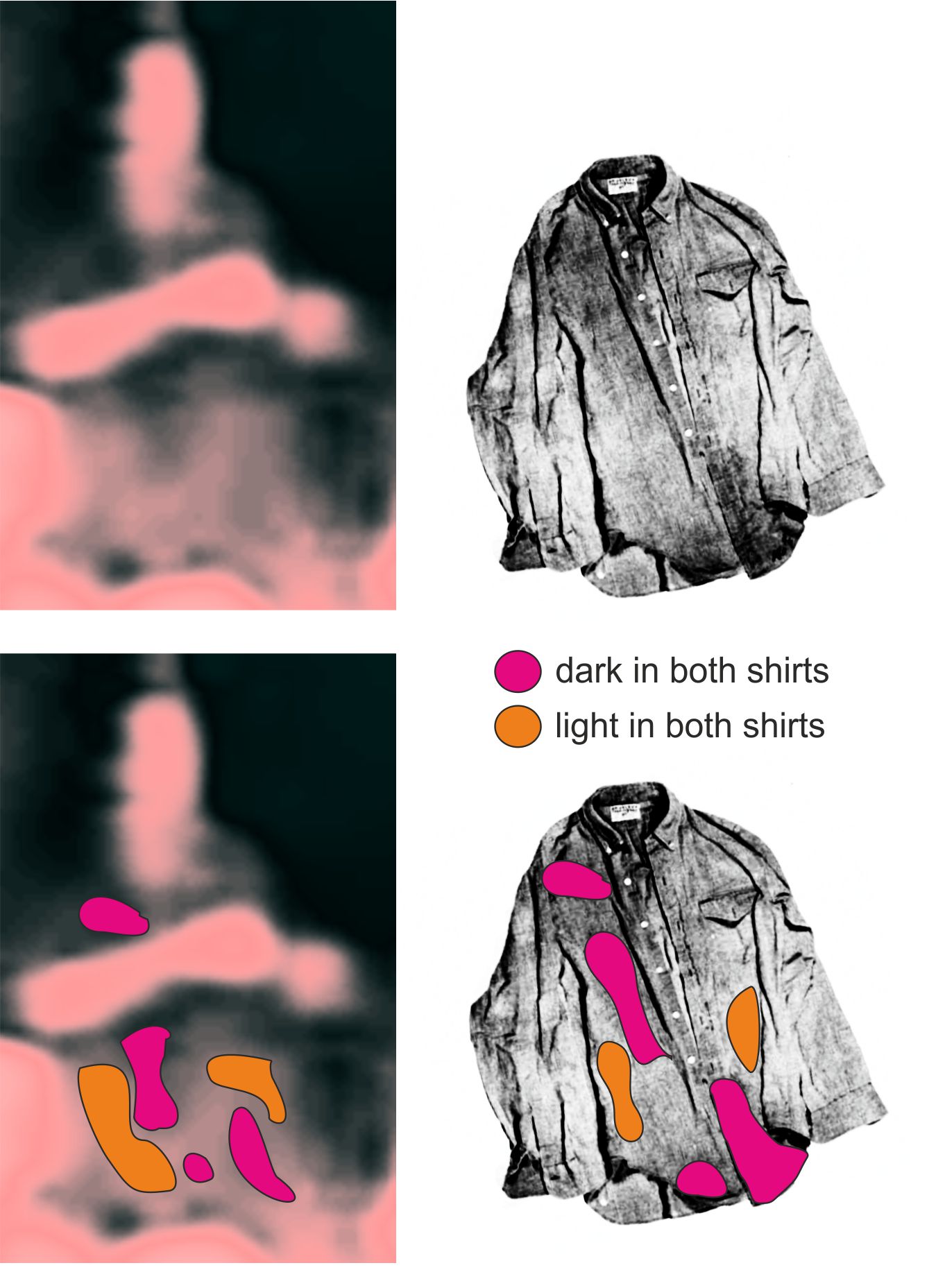
It is everyone’s right and responsibility to make a judgment: are the similarities in the patterns of light and dark tones in both shirts present, and can those spots occur at similar places just by chance?
It may not be possible to receive a direct confirmation of Prayer Man’s identity from one living witness, and what remains is to build the case on circumstantial evidence. This is the reason for clarifying every single and minute aspect of Prayer Man figure and to determine whether a particular feature would be compatible with Lee Oswald at all, and what probability would there be that a feature seen in Prayer Man would occur in Lee Oswald just by chance. Whatever feature explored so far was fully compatible with Lee Oswald's features.
If the distribution of the dark, dirty spots on CE151 matches that in Prayer Man’s shirt, it would be hard to deny that Lee Oswald was out, in the doorway just after the shooting and could not be the assassin.
I have sent a request to NARA to send me for a fee the photograph of CE151 as published in Warren Commission Hearings, vol. 16, and I very much hope that it would be possible. However, we need also a better copy of Darnell as the questions posed here could be answered with greater certainty if both photographs are of high quality. How can we obtain one single frame of Darnell from the 6th Floor Museum?
In the coming weeks and months, I will refocus on reviving Tom Wilson’s image analysis method and will subject the CE151-WC, CE151-2016 and Prayer Man in the Darnell still to this type of analysis because it offers the capacity to visualise layers and anomalies in materials.
-
There is one more similarity between Robert Oswald and Prayer Man which stroke my eye when searching for Robert's pictures. Do you see any similarities in body postures of the two figures? In both men, the body weight rests on the right foot, the left foot is slightly forward and bent in the knee joint, the shoulder line is tilted slightly toward the right as is the head.

-
To continue the hairline aspect in Prayer Man's figure, let us look at the hairline of Lee Oswald's own brother, Robert. Robert was 4-5 years older than Lee and they both fell into the same age category 18-29 years in 1963. The genetic contributions to male baldness are strong. One recent genetic association study (Hagenaars et al., PlOS Genet., 2017, 13: e1006594) revealed that a set of snips has explained 51% of the occurrence of male baldness. Some data suggest that male baldness is inherited from the father of a male's mother.
So, if Prayer Man has Type II hair pattern according to the Norwood scale, and Lee Oswald has the same type of hairline, would Robert Oswald also show the Type II pattern?
The figure below is a composite of two Robert's pictures taken during Lee's funeral, and the schematic Type II pattern of baldness from Norwood scale.
Robert, Lee's own brother, showed a similar Type II hair pattern as Lee (not surprising), and Prayer Man's hair pattern was also Type II. What is the probability that Lee Oswald would have the same type of hair pattern as Prayer Man, and Lee's own brother would have it too?
-
It seems at times that Prayer Man is just a blurred figure about which nothing can be known except that the person was "large". I disagree with that view. Actually, we know already quite a lot about Prayer Man and I hope we learn even more.
Let us look at Prayer Man's hairline. Of course, the image is blurred and therefore, it would be hard to convince anyone that Prayer Man had exactly Lee Oswald's hairline. However, we can still use the hairline to narrow down the basic population from which Prayer Man could be chosen. It is about the probabilities of independent physical features in Prayer Man's figure. The better and more objectively we can determine the likelihood with which a certain feature could show similarity to Lee Oswald (or any other candidate person), the more accurate can we also estimate the odds with which Lee Oswald would be Prayer Man.
While claiming identity between Prayer Man's hairline and Lee Oswald's hairline would hardly fare well, we still can categorise Prayer Man's hair pattern according to well-established scales.
Hamilton's (Annals of New York Academy of Sciences, 53: 703-728,1950) and especially Norwood 's (Southern Medical Journal, 11: 1359-1365, 1975) scale of patterns of human baldness are well-established categorisation scales used in medicine to study baldness from many aspects such as genetics, hormones, risk of certain diseases etc. The Norwood scale basically divides male hair patterns into balding (III-VII) and non-balding (I-II) patterns.
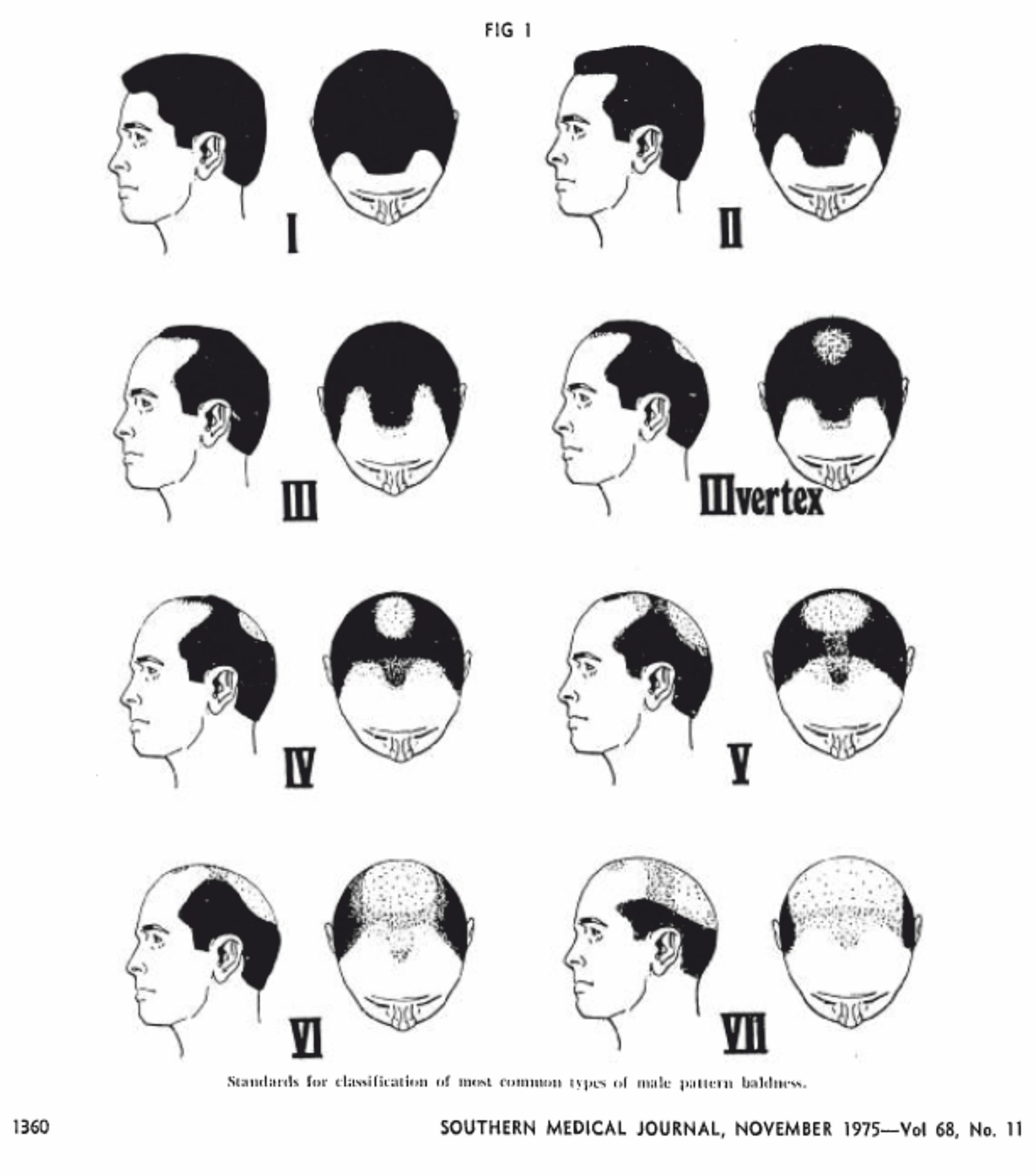
The course of Prayer Man's hairline is delineated in the figure below. Please check if the yellow contour line in the right-hand panel would adequately copy Prayer Man's hairline in the enhanced image (middle panel).
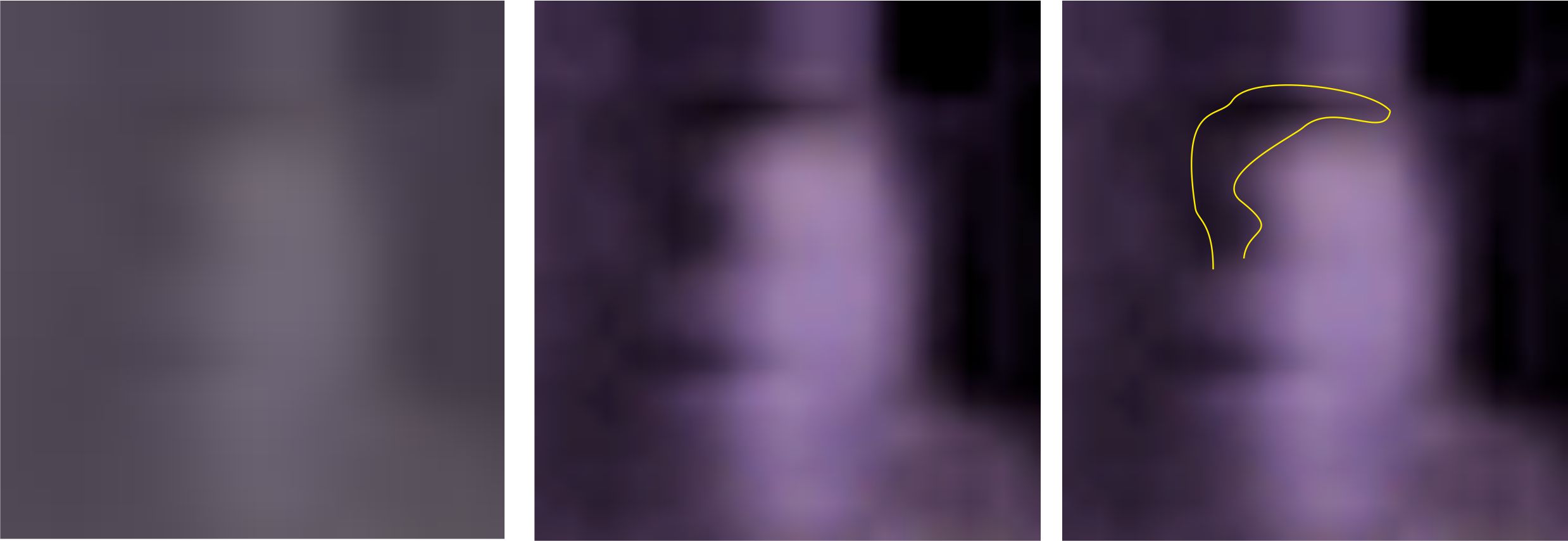
This type of hairline, appears to be a non-balding hairline of type II with some minor receding hair in frontal temples. The next figure shows enhanced Prayer Man's hairline along with a profile view of Lee Harvey Oswald and the type II hair pattern from the Norwood scale.
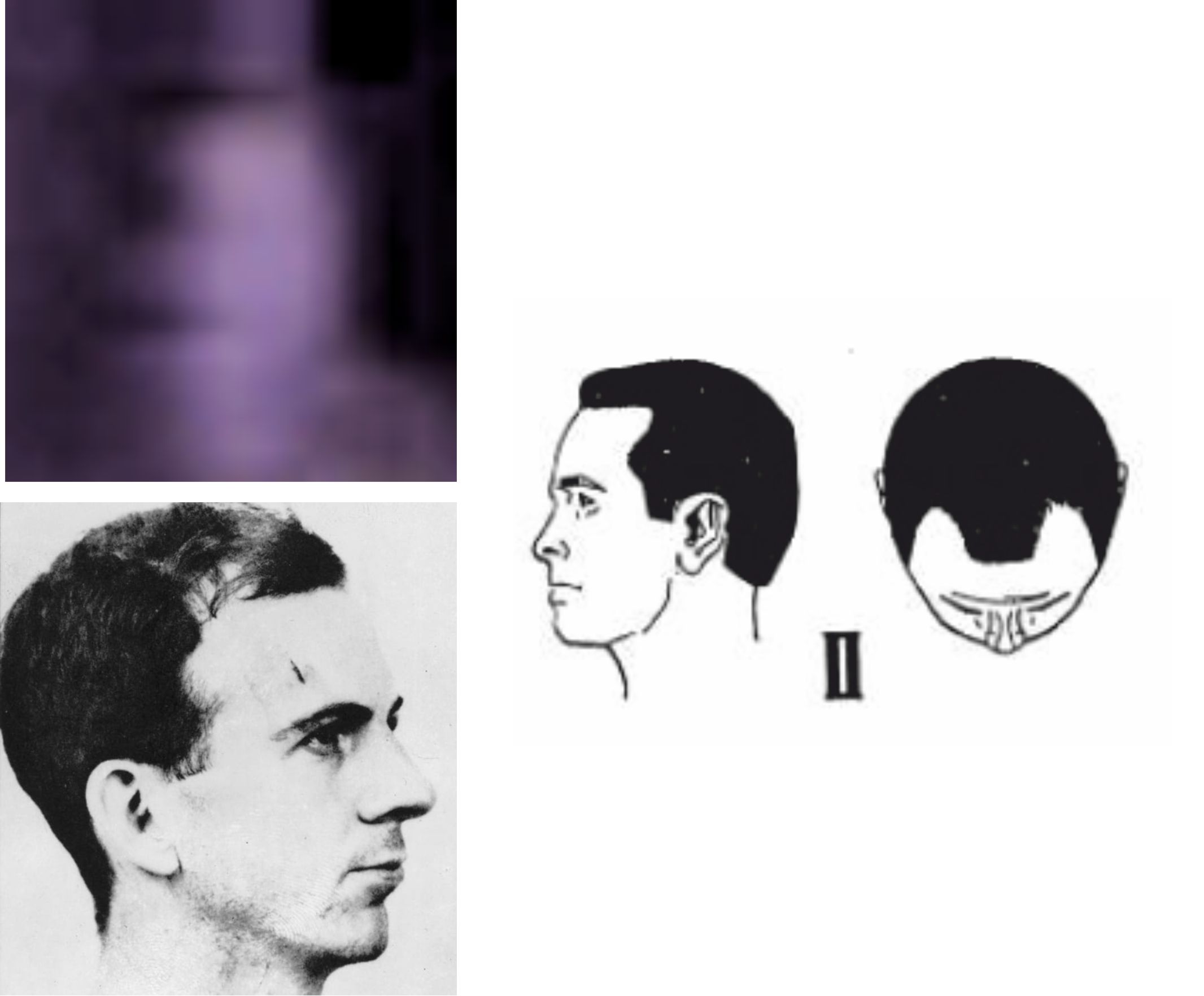
The non-balding pattern II occurs in roughly 20% of the male population over the age categories from 18 to 80 years. Here is the table from the original Norwood's article giving the percentages for each type of hair pattern in different age groups:
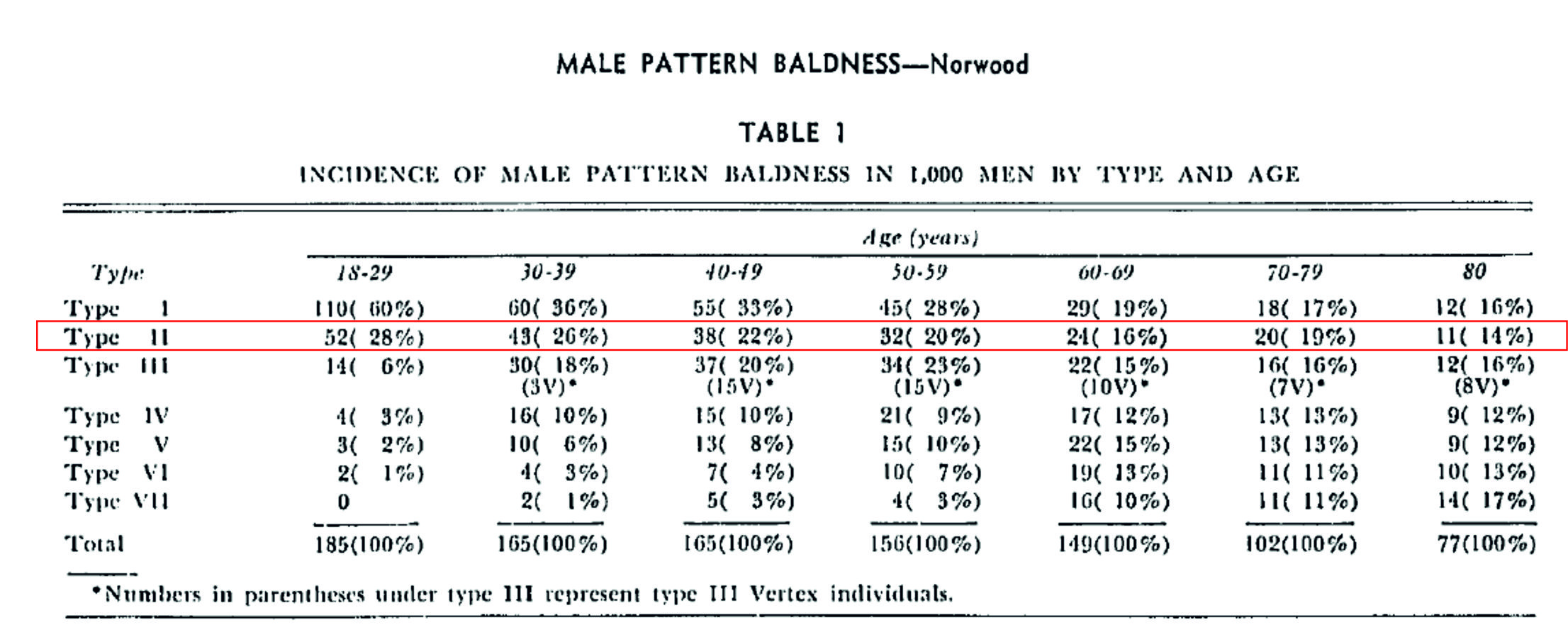
The age group 18-29 years is represented the most in type II hair pattern, however, it can be seen across all age groups until very old age. The probability that a male having the type II hair pattern would be of 18-30 years is p = 0.2.
So, Prayer Man was a non-balding male with a hair pattern represented in about 20% of the male population. There is a slightly larger probability that this man would be young (18-29 years, 28%) than old (70 years, 19%) but not too different from a middle-aged man (30-39%, 26%).
Similar frequency data can be found in Setty (American Journal of Physical Anthropology, 33: 49-56, 1970) which included 300 white males and 300 Afro-Americal males. This study, however, used a different categorisation scale compared to Norwood (1975).
A small quiz at end: which of the hairlines in the two persons displayed next to Prayer Man's head could match Prayer Man' hairline?
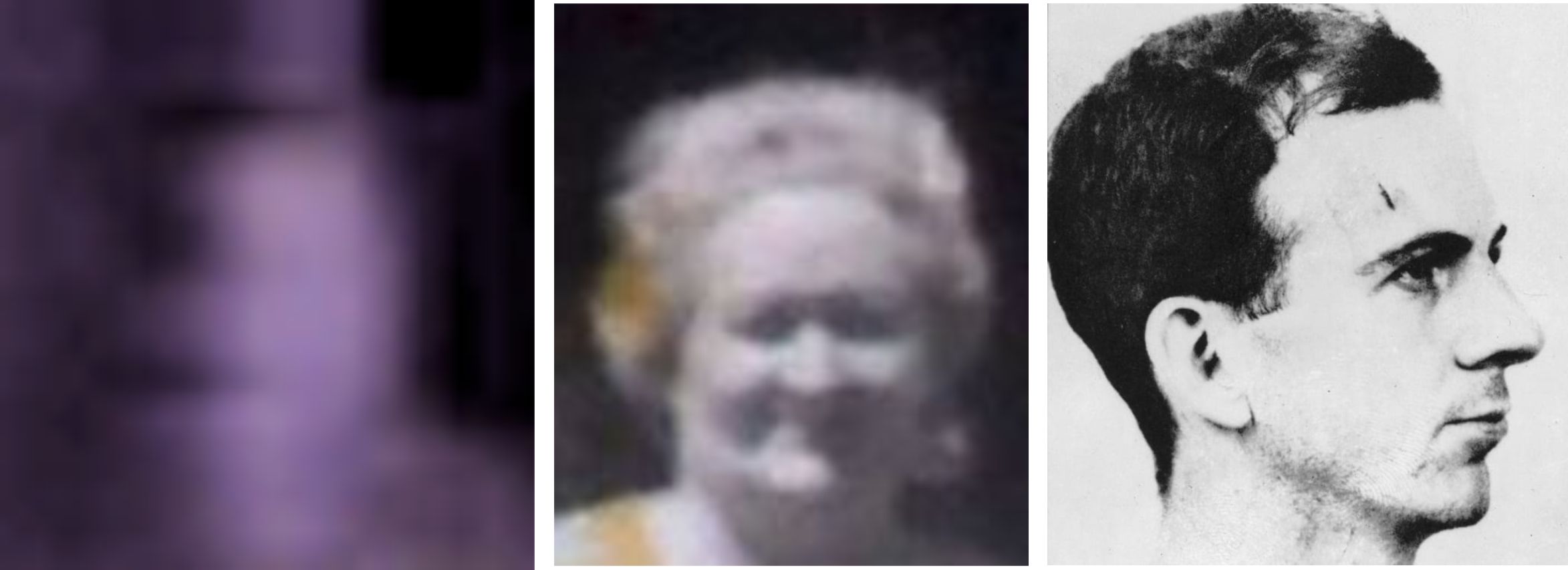
-
Pat:
thanks for your detailed comments on Mr. Frazier's memory recollection. The situation you describe when a pre-knowledge determines the memory outcome is understandable and it certainly does not help to the possibility of Lee Oswald being Prayer Man. Mr. Frazier's positive identification of Prayer Man would solve the problem of Prayer Man identity.
Late edit: the thing is that Mr. Frazier built his rejection of Lee Oswald based on a recall of time samples from before and after the shooting. However, he may have not noticed him as Lee would be out for maybe 35 seconds and in the most dramatic period when people stood in shock. Thus, Mr. Frazier created a memory trace going throughout the whole period to reject Lee Oswald's presence in the doorway but he may have missed a short period.
However, Mr. Frazier's memory traces as far as Lee Oswald is concerned are at least problematic. The most blatant case are his statements for the Warren Commission in which he said that he returned into the building right after a girl who was passing by told them about the shooting:
Mr. BALL - Then you went back into the Building, did you?
Mr. FRAZIER - Right.
Mr. BALL - And before you went back into the Building no police officer came up the steps and into the building?
Mr. FRAZIER - Not that I know. They could walk by the way and I was standing there talking to somebody else and didn't see it.
Mr. BALL - Did anybody say anything about what had happened, did you hear anybody say anything about the President had been shot?
Mr. FRAZIER - Yes, sir; right before I went back, some girl who had walked down a little bit further where I was standing on the steps, and somebody come back and said somebody had shot President Kennedy.
Mr. BALL - Do you know who it was who told you that?
Mr. FRAZIER - Sir?
Mr. BALL - Do you know who the girl was who told you that?
Mr. FRAZIER - She didn't tell me right directly but she just came back and more or less in a low kind of hollering she just told several people.
Mr. BALL - Then you went back into the Building, did you?
Mr. FRAZIER - Right.
Mr. BALL - And police officers came in there?
Mr. FRAZIER - Yes, sir; I would say by the time, you know some of us went back in, and it wasn't just a few minutes, I say there were several.
Mr. BALL - Did you stay on the first floor?
Mr. FRAZIER - Well, stayed on the first floor there for a few minutes and I hadn't eaten my lunch so I had my lunch down there in the basement and I went down there to get my lunch and eat it and I walked back up on the first floor there.
Mr. BALL - When you came back into the Building, you came in the front door, didn't you?
Mr. FRAZIER - Right
Mr. BALL - Did you go down to the basement immediately or did you stand around on the first floor?
Mr. FRAZIER - No, sir; I stood around for several minutes there, you know, and then, you know, eventually the ones who hadn't eaten their lunch, some of them had taken their lunch outside.
However, from about 2002, Mr. Frazier started to tell a very different story about what happened after the shooting. This is a transcript of Mr. Frazier's interview from 2013. Alistair Bricks was able to identify an earlier interview of Mr. Frazier containing the same story as his 2013 interview:
The transcript from the "Living History with Buell Wesley Frazier" interview recorded by the Sixth Floor Museum and posted on August 27, 2013. Mr. Fagin led the interview. The interview can be found on YouTube.com by typing the title of the video broadcast.
The relevant section of the interview starts at 33 min 50 s:
Mr. Fagin: In the chaos that followed the shooting, did you see Oswald at all?
Mr. Frazier: (pause) I did. This was all... I do not know how many minutes later … (noisy recording), but the lady I stand next to. Some of the people, Bill Shelley and Mr. Billy Lovelady, they went down towards the Triple Underpass because before they went down there, a lady came by, a woman came by, she was crying and she said "Somebody has shot the President".
So we looked ...(unintelligible). And I turned to Sarah: "She said somebody shot the President", I said I doubt what she said. She said that she did say that. So we stayed there for few minutes, and, and I walked down to the first step where Billy was standing there by myself so to look around it. And it was just total chaos there.
And then forbear I started to go down if I can see Bill Shelley and Billy Lovelady, and it was so much chaos down there. And I said, well, I better go back to work, go back to the steps, so now, and I did, I walked back to the bottom of the steps, and then I walked out to the corner of the building right there where Houston comes side of the building. And I was talking to someone, it was a lady, and I looked to my left, and come walking alone the side of the Texas School Book building was Lee Oswald.
Mr. Fagin: walking along this side of the building?
Mr. Frazier: Yes.
Mr. Fagin: Houston Street.
Mr. Frazier. Yes, Houston Street. So, he'd come around after the dock there. So, he walks up and I talked to this lady. He didn't say anything. And he crosses Houston. I watch him crossing Houston as I talked to this little lady. and as he gets over to the other side of Houston, and then he crosses Elm. And somebody said something to me and I turned, and he was about half-way across the street, and when I turned back he was gone in the crowd, and I don’t know what happened to him. But I did not worry too much about that because there were several places around there where you can go when you need a sandwich, and I never asked him that morning when he and I were riding to work, and I says: Where is your lunch? He said: Oh, I will buy off the truck today. I said: “OK”, Well, I didn’t think anything when he told me about buying off the truck.
He said, buy his lunch, “I will buy my lunch today”, and … I did not like … (unintelligible) so, but I though he was talking about "Cader Crock" (I not sure I have transcribed this name correctly) , but …
Mr. Fagin: There is no doubt in your mind that this was Lee Harvey Oswald?
Mr. Frazier: This (They?, AS) was.
Mr.Fagin: Could you see the expression of his face, or anything you can tell us about the way he looked?
Mr. Frazier: There was nothing different about Lee. Expression on his face was … He looked perfectly normal. And that’s the last time I remember seeing him.
--------------
You may understand that it is too much of a memory lapse to say to Warren Commission about seeing Lee only in morning hours and immediately returning to the first floor (into the building) only to say later that he went to the corner of Houston and saw Oswald again. Does this prove Mr. Frazier flawless memory? How can we be certain in his statement about Prayer man not being Oswald if he was able to change his interpretation of events so substantially?
I have also highlighted in bold his direct statement about Lee saying that he will buy lunch on Friday "I will buy my lunch today". This is not what Lee told the interrogators. I have a big problem with the lunch sack because it shows that Mr. Frazier was able to deny a sensitive part of Lee Oswald's alibi.
-
Chris:
break time is a good thing.
A 3D problem such as the location of a human body in a specific posture in a space cannot be solved by drawing lines on an inaccurate 2D plan of the doorway. Your red line pointing to Prayer Man is wrong - his head would not be crossed by the aluminum frame. Sorry. You would need to move him closer toward the centre so that the line would at least cross the back corner of the top landing. If you would then plot the shadow line (your shadow line) and also figure out the orientation of the body and hands as they really are, maybe you would start seeing it as Darnell shows it.
-
Chris:
I reckon that your 5'3'' and my 5'2 4/8 for the height of the top of Prayer Man's head above the top landing are pretty close estimates, aren't they?
I would like to turn your attention to the problem of body proportions which your excellent math may have not taken into account yet. It refers to the problem of how close Prayer Man's right elbow was relative to the head of the person on the second step. Of course, this man was some 3-4 steps away from Prayer Man but what matters are the 2D projections of his and Prayer Man's figures. I get the exact location of the right elbow relative to that man's head only if Prayer Man stands with his right foot on the second step, but not if Prayer Man is a short person 5' 2'' 4/8 (or your 5'3'', it does not matter in this case). A man 5'2'' or 5'3'' standing on the top landing will not have his arms at the same height as a man reaching with his head to the same height but standing one step below. I have explained this detail in my yesterday post, the one with 5-6 images. This means, that his right elbow of the short Prayer Man standing on the top landing will be too far from the man's head due to the combination of three factors: 1. The short Prayer Man is farther away from that man compared to the tall Prayer Man, 2. The arms of the short Prayer Man will also be 2 inches higher compared to the tall Prayer Man even if their heads reach the same heights, 3. A short person will also have shorter arms than a tall person, which moves the right elbow further from the man on the lower step. I showed an example with Mrs. Stanton in my previous post who was set to 5'5'' (this is because some people were adamant that Mrs. Stanton was 5'5'' last year and only changed their mind after seeing that that's too much and simply started to claim that she was 5'4''). You can see the big gap between Mrs. Stanton's mannequin and the location of Prayer Man's elbow.
I hope you find my explanation for my preferred Prayer Man's posture with one foot on a lower step reasonable.
Late edit: Chris, would you agree that a person 5' 9 1/2'' would hardly be a woman?
-
Chris:
It looks like your location for Buell Wesley Frazier in Darnell is similar or the same as it is in my model. Please see the overhead view in my lengthy post with a number of pictures. Frazier's figure cannot ber too close or too far from the edge of the top landing because the shadow crossing his left shoulder would change. Actually, I can move his figure neither to the right or left by a single inch, and nor can I move it front or back (the shadow problem). The same with Prayer Man. If I would move him one inch to the right, he would step out of the shadow and his belly would be lit by the sunlight. If I move him to the left, his head would not be aligned with the vertical pole of the aluminum frame. If I push him backward (toward the glass door), his right foot will be buried in the concrete of the top landing and his right elbow will be too far from the head of the man on the second step. And if I push him to the front, a large part of his body will be in the sunlight. It is that tight and that sensitive to deviations from one ideal location.
-
I made a table outlying different statements and scenarios (some of which Mr. Frazier said) and their relevance. There are only two scenarios in which Mr. Frazier's statement regarding Prayer Man could be considered relevant: 1. Lee Oswald was Prayer Man and Mr. Frazier confirms. 2. Someone else than Lee Oswald was Prayer Man and Mr. Frazier reveals his/her identity which will be proved to be the truth. Every other scenario leaves the possibility of Lee Oswald being Prayer Man open. The research on Prayer Man has great significance because it is only the knowledge that has been acquired in the process of finding Prayer Man's identity that can be used to test any of Mr. Frazier's statements. Further, this research can provide a number of clues which together provide compelling circumstantial evidence allowing to decide whether Lee Oswald was Prayer Man.
Scenario
Mr. Frazier denies Prayer
Man being Lee Oswald
Mr. Frazier confirms Prayer Man was Lee Oswald
Mr. Frazier was not aware of Prayer Man’s presence (attentional blink)
irrelevant
irrelevant
Mr. Frazier suffered a selective loss of memory and cannot recall Prayer Man’s presence
irrelevant
irrelevant
Mr. Frazier saw Lee on steps as Prayer Man
irrelevant
relevant
Mr. Frazier saw someone else than Lee Oswald on steps but he cannot recall his/her identity
irrelevant
irrelevant
Mr. Frazier saw someone else than Lee Oswald on steps and provides an incorrect identification
irrelevant
not applicable
Mr. Frazier saw someone else than Lee Oswald on steps and provides a correct identification
not applicable
relevant
-
Chris:
thanks for your explanations. The tonal values of objects in black-and-white photographs taken by different cameras and film materials are not comparable. There is no point in comparing a white helmet in a shadow with a human skin exposed to sunlight.
The body height problem: if you think Prayer Man was 5'6'' and was standing further back on the top landing, you would face the problem of comparing his 5'6' with Mr. Frazier's 6'. This would put the level of Prayer Man head (the top) to about the root of the nose in Frazier's figure. This is not the case. If you place Prayer Man closer toward the aluminium frame, his right elbow will be hopelessly far from the head of the man standing on the second step.
I have done very little modelling with Wiegman film and cannot comment on all details of Prayer Man's location and body posture yet. However, it appears that he stood in much the same way as in Darnell, however, he was rotated slightly more to his right and may also be shifted an inch or two closer to the western wall. I would see nothing strange in seeing such minor differences in Prayer Man's posture between Wiegman and Darnell.


Prayer Man is a Man
in JFK Assassination Debate
Posted · Edited by Andrej Stancak
In the process of retrieving as much information from Darnell film as possible to be able to model correctly Prayer Man's figure but also other features of the doorway (e.g., radiator), I decided to upload into ImageJ one by one all Darnell stills showing the doorway. I stumbled on two frames which appear to carry some information about Prayer Man's facial features. The frames are #003520 and #003704_1_2_1. The former frame is one of the first frames showing the doorway and it looks quite beaten up. The latter is one of 11 frames starting with 003704 which I previously considered to be identical and therefore, I have always used the first of these frames.
The orientations of Prayer Man's head and left arm differ between these two frames; in frame #003520, Prayer Man has his head turned more toward his right, and his posture resembles Prayer Man's posture in Wiegman film.
The figure below shows the cropped Prayer Man's head in #003520 processed with ImageJ. In spite of a blurred blob to the right of Prayer Man's head, at least some faint facial features are visible.
The next figure shows this head under different contrasts (upper panel) and some selected photographs of Lee Oswald showing his head from a similar angle as Prayer Man's head (lower panel).
Please note the course of the hairline in the region of the left temple in Prayer Man's and Lee Oswald's head. The similarity is uncanny. However, the slightly extruded part of Lee's face between the nose and upper lip can also be seen in Prayer Man's face.
Lee Oswald's head in second photograph from the right appears have very similar orientation to Prayer Man's head and therefore, I have tried an overlay of the two pictures. The percent values above each of six overlays shown below correspond to the amount of blending with zero percent standing for original photograph with no overlay. The 1% and 2% overlays are perhaps the most important ones as they allow to evaluate the similarity between Lee Oswald's head and Prayer Man's head.
As far as the later frame #003704_1_2_1 is concerned, the facial features can hardly be recognised in Prayer Man's head, however, the course of hairline in the right temple region is clear and again shows an unusual similarity with Lee Oswald's hairline. Again, the top row shows Prayer Man's head extracted from #003704_1_2_1 using ImageJ program under different contrasts (upper row) and selected pictures of Lee Oswald head.
Do you find similarities between Prayer Man's head and Lee Oswald's head? Or, is Prayer Man's head more similar to the head of Mrs. Stanton shown below?